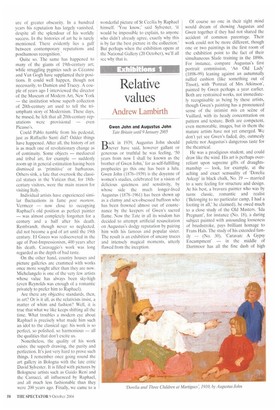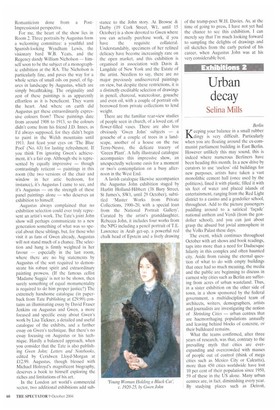Relative values
Andrew Lambirth
Gwen John and Augustus John Tate Britain until 9 January 2005
Back in 1939, Augustus John should never have said, however gallant or generous or truthful he was feeling, '50 years from now I shall be known as the brother of Gwen John,' for as self-fulfilling prophecies go this one has been a lulu. Gwen John (1876-1939) is the doyenne of women's studies, celebrated for a vision of delicious quietness and sensitivity, by whose side the much longer-lived Augustus (1878-1961) has been shown up as a clumsy and sex-obsessed buffoon who has been frowned almost out of countenance by the keepers of Gwen's sacred flame. Now the Tate in all its wisdom has decided to attempt artificial resuscitation on Augustus's dodgy reputation by pairing him with his famous and popular sister. The result is an exhibition of uneasy truces and intensely magical moments, utterly flawed from the inception.
Of course no one in their right mind would dream of showing Augustus and Gwen together if they had not shared the accident of common parentage. Their work could not be more different, though one or two paintings in the first room of the exhibition point to the fact of their simultaneous Slade training in the 1890s. For instance, compare Augustus's first portrait commission, 'An Old Lady' (1898-99) leaning against an autumnally ruffed cushion (like something out of Tissot), with 'Portrait of Mrs Atkinson', painted by Gwen perhaps a year earlier. Both are restrained works, not immediately recognisable as being by these artists, though Gwen's painting has a pronounced sense of the intimist mis en scene of Vuillard, with its heady concentration on pattern and texture. Both are competent, even memorable, images, but in them the mature artists have not yet emerged. We don't yet see Gwen's faded, dry, oatmealy palette nor Augustus's dangerous taste for the theatrical.
He was a prodigious student, and could draw like the wind. His art is perhaps overreliant upon supreme gifts of draughtsmanship — look, for example, at the aching and exact sensuality of `Dorelia Asleep' in black chalk, No. 19 — married to a sure feeling for structure and design. At his best, a bravura painter who was by turns classic, romantic and realist ('Belonging to no particular camp, I had a footing in all,' he claimed), he owed much to a close study of the Old Masters. 'Ida Pregnant', for instance (No. 18), a daring subject painted with astounding looseness of brushstroke, pays brilliant homage to Frans Hals. The study of his extended family — (No. 30), 'Caravan: A Gypsy Encampment' — in the middle of Dartmoor has all the fine dash of high
Romanticism done from a PostImpressionist perspective.
For me, the heart of the show lies in Room 2. Three portraits by Augustus form a welcoming committee; a youthful and Spanish-looking Wyndham Lewis, the visionary bard W.B. Yeats, and the Regency dandy William Nicholson — himself soon to be the subject of a monographic exhibition at the RA. The Nicholson is particularly fine, and paves the way for a whole series of small oils on panel, of figures in landscape by Augustus, which are simply breathtaking. The originality and zest of these paintings is as apparently effortless as it is beneficent. They warm the heart. And where on earth did Augustus get these extraordinarily expressive colours from? These paintings date from around 1908 to 1913, so the colours didn't come from his friend J.D. Innes, as I'd always supposed, for they didn't begin to paint in the Welsh mountains until 1911. Just feast your eyes on 'The Blue Pool' (No. 63) for lasting refreshment. If you think I'm ignoring Gwen's achievement, it's a fair cop. Although she is represented by equally impressive — though contrastingly reticent — paintings in this room (the two versions of the chair and window in her attic bedroom, for instance), it's Augustus I came to see, and it's Augustus — on the strength of these panel paintings alone — who deserves an exhibition to himself.
Augustus always complained that no exhibition selection could ever truly represent an artist's work. The Tate's joint John show will perhaps communicate to a new generation something of what was so special about these siblings, but, for those who visit it as fans of Gwen already, Augustus will not stand much of a chance. The selection and hang is firmly weighted in her favour — especially in the last room, where there are no big statements by Augustus of the sort required to demonstrate his robust spirit and extraordinary painting prowess. (If the famous cellist 'Madame Suggia' is not to be shown, then surely something of equal monumentality is required to do him proper justice?) The extremely handsome catalogue (in paperback from Tate Publishing at £2999) contains an illuminating essay by David Fraser Jenkins on Augustus and Gwen, a more focused and specific essay about Gwen's work by Lisa Tickner, a detailed and useful catalogue of the exhibits, and a further essay on Gwen's technique. But there's no essay focusing on Augustus or his technique. Hardly a balanced approach, when you consider that the Tate is also publishing Gwen John: Letters and Notebooks, edited by Ceridwen Lloyd-Morgan at £12.99. Augustus, though blessed with Michael Holroyd's magnificent biography, deserves a book to himself exploring the riches and limitations of his art.
In the London art world's commercial sector, two additional exhibitions add sub
stance to the John story. At Browse & Darby (19 Cork Street, Wl, until 15 October) is a show devoted to Gwen where you can actually purchase work, if you have the requisite collateral. Understandably, specimens of her refined delicacy have become increasingly rare on the open market, and this exhibition is organised in association with Davis & Langdale of New York and the Estate of the artist. Needless to say, there are no major previously undiscovered paintings on view, but despite these restrictions, it is a distinctly creditable selection of drawings in pencil, charcoal, watercolour, gouache and even oil, with a couple of portrait oils borrowed from private collections to lend weight.
There are the familiar rear-view studies of people seen in church, of a loved cat, of flower-filled vases. There are also less obviously 'Gwen John' subjects — a gouache of a couple of trees in a landscape, another of a house on the rue Terre-Neuve, the delicate tracery of 'Green Plant'. A fully illustrated catalogue accompanies this impressive show, an unexpectedly welcome oasis for a moment or two's contemplation on a busy afternoon in the West End.
A lavish catalogue likewise accompanies the Augustus John exhibition staged by Hazlitt Holland-Hibbert (38 Bury Street, St James's, SW1, until 29 October), subtitled 'Master Works from Private Collections, 1900-20, with a special loan from the National Portrait Gallery'. Curated by the artist's granddaughter, Rebecca John, it includes four works from the NPG including a pencil portrait of T.E. Lawrence in Arab get-up, a powerful red chalk head of Epstein and a lively drawing of the tramp-poet W.H. Davies. As, at the time of going to press, I have not yet had the chance to see this exhibition, I can merely say that I'm much looking forward to sampling the delights of drawings and oil sketches from the early period of his career, when Augustus John was at his very considerable best.



















































































































 Previous page
Previous page